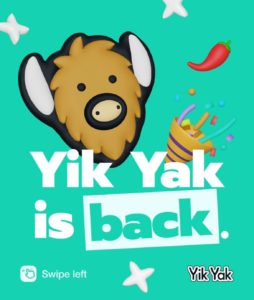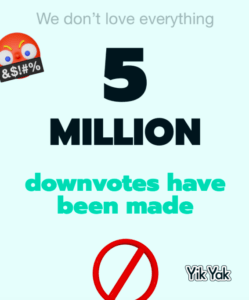The Return of Yik Yak: Crisis Averted?
Published on September 23, 2021, at 9:10 p.m.
by Gabrielle Jolly.
“The Yak is Back,” but is it here to stay?

The controversial platform made its startling return in August 2021 and caused quite an uproar around college campuses. Following an initial bankruptcy in 2017, Yik Yak remained dormant for four years after experiencing crisis management issues involving cyberbullying, hate comments and threats published on the medium.
Yik Yak allows users to post anonymous comments available to anyone within a five-mile radius. As it turns out, the posts aren’t the only anonymous elements to the app. The new owners of Yik Yak remain unknown, yet pledge to curb the pitfalls of the previous owners’ demise. The initiatives under new ownership include stricter community guidelines, mental health resources and the expectation for accountability among users.
The updated interface of the app utilizes a sidebar where users can locate various resources related to bullying, mental health and overall mindfulness. The sidebar also contains the phone numbers of these organizations for users to access at all times. The guidelines focus on unified accountability and encourage the input of all users, where a comment with five “downvotes” or dislikes will result in deletion of the post.

While Yik Yak promises to prevent harmful speech on its platform, many remain unsure of its censoring abilities. Whether a comment is removed after five “downvotes” or not, the digital age of screenshots and instant text messaging proves to be a liability for the medium. Mixed reactions from past and present users have created a future of uncertainty for the platform. Many have expressed their concern about the instantaneity of these comments and the delayed response that comes with removing hate speech. This model can lead to many challenges regarding the topic of “anonymity” that can easily spiral out of control if not consistently regulated.
Conversations regarding mental health have grown increasingly important in today’s digital age, along with the concern that certain media outlets may fall into the hands of younger generations. Minors are an impressionable age group, and the cyberbullying component of this platform has the potential to cause problems within schools and local communities. While Yik Yak markets itself to young adults, there are no restrictions on who can and cannot download the free app. Furthermore, the use of this platform by younger audiences poses a potential risk for legal implications and a tarnished reputation for the brand in the future.
We all know comebacks are certainly possible, and many different brands have thrived under new ownership after an initial failure. However, this development begs the ultimate question: Has Yik Yak done enough to thrive in 2021’s market? Likewise, will Yik Yak be able to capture its 2014 level of popularity while establishing a stable relationship with 2021 consumers?
The “experience millions knew and loved” has returned, but is this experience for the better — or worse?




